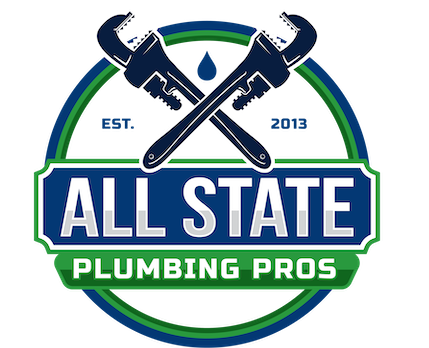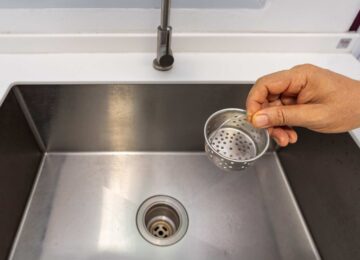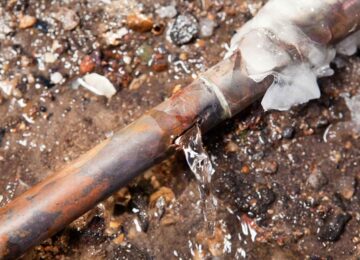When your main water shut-off valve fails, even a minor leak can turn into serious water damage. This essential valve controls the entire flow of water into your home, serving as the first line of defense against flooding and burst pipes, ensuring your security. Unfortunately, old gate valves often corrode, stick, or develop leaks over time, making them unreliable when you need them most.
If you live in Fairfield County, CT, or Westchester County, NY, learning how to change a main water shut-off valve is one of the most valuable plumbing skills you can have. In this guide, we’ll explain each step of the replacement process, share safety tips, and show you when it’s best to call a licensed professional for help.
Need help right away? Contact All State Plumbing Pros for 24/7 emergency plumbing services. Our certified plumbers replace, repair, and install main shutoff valves, well pumps, and water heaters across Connecticut and New York, ensuring your water system stays secure and reliable year-round, with proper verification upon installation.
Why the Main Water Shut-Off Valve Matters
Your main shutoff valve regulates all incoming water lines from the street-side connection or well pump to your house. It allows you to stop water flow during maintenance, repairs, or emergencies such as pipe bursts. When this main valve fails, you lose the ability to control leaks or flooding. One common problem is that a stuck or malfunctioning valve can prevent you from shutting off water quickly in an emergency, leading to more extensive damage.
Older homes often have gate valves, which use a metal wedge to control flow. These valves require multiple turns and can seize up from mineral buildup. Modern ball valves, sometimes called port ball valves, feature a single lever that rotates a metal sphere to instantly stop or start water flow.
A new ball valve offers smoother operation, better sealing, and long-term durability. If you notice moisture around the handle, difficulty turning it, or hear hissing near the line, it’s time to schedule a replacement. We hope that addressing the issue early will prevent water damage and avoid more costly repairs.
If you’re unsure about the condition of your valve, an inspection from a licensed emergency plumber ensures your system stays secure and code-compliant.
Safety Checklist Before You Begin
Replacing your main valve involves handling water pressure, metal fittings, and sometimes heat. Before you start, make sure you take the right safety precautions to avoid costly damage or injury.
Here’s what to do before beginning to remove the old valve :
- The act of shutting off the main supply at the street curb or meter using a curb key is essential for safety before any work begins. If you’re on a well system, switch off the electrical breaker.
- Turn off water heaters and appliances to prevent backflow or heating damage.
- Drain remaining water by opening a basement or outdoor faucet.
- Prepare tools and supplies like adjustable wrenches, Teflon tape, pipe dope, and a bucket.
- Protect yourself with gloves and eye gear when cutting or soldering joints.
If your street-side shutoff valve doesn’t fully close or water continues to flow, stop immediately and contact All State Plumbing Pros. We offer same-day valve replacement and emergency service in Danbury, New Milford, Ridgefield, and surrounding towns.
Where to Find Your Main Water Shut-Off Valve
Before you can replace anything, you’ll need to locate and verify the valve itself. The main shutoff is typically installed on the water line entering the house, usually near the water meter, pressure regulator, or well tank.
Common locations include:
- Basement or mechanical room near your water heater.
- Crawl space or slab entry point where the main line enters.
- Utility room, garage, or closet in newer construction.
- Exterior wall facing the street connection.
- An outdoor curb stop box is buried near the sidewalk.
In cold-weather states like Connecticut and New York, valves are usually installed inside basements to prevent freezing. If yours is behind finished walls or under flooring, you may have to assume its location based on the routing of visible pipes. However, it’s better to consult a professional plumber than to guess where the valve is and risk damaging walls or flooring unnecessarily. A professional can determine the location and install an access panel for future maintenance.
Choose the Right Replacement Valve Type
Not all shutoff valves are the same. Choosing the correct type ensures your plumbing system remains leak-free and easy to maintain. Among the options, a compression valve is a common and user-friendly choice for DIY replacements, offering straightforward installation without the need for soldering.
Ball Valve vs Gate Valve
A ball valve uses a rotating sphere with a hole through its center. When aligned with the pipe, water flows freely; when turned perpendicular, it completely blocks the line. In contrast, old gate valves use a sliding gate that wears down and can seize after years of use.
For most modern homes, upgrading to a full-port ball valve is the best choice. It allows unrestricted flow, reliable shutoff, and minimal maintenance compared to older designs.
Compression vs Solder vs Push-Fit Connections
The method you choose to install the valve depends on your pipe material, skill level, and available tools.
| Connection Type | Skill Level | Tools Required | Notes |
|---|---|---|---|
| Compression | Beginner | Wrench, pipe cutter | Ideal for copper or PEX lines; simple and reusable. Make sure the pipe end is clean and smooth for a proper seal. |
| Solder (Sweat) | Intermediate | Torch, flux, solder | Requires heating copper joints; offers a strong, permanent seal. Using the correct torch bit can make soldering copper pipe ends easier and more effective. |
| Push-Fit (SharkBite) | Easy DIY | None | Quickest method; uses internal O-rings for watertight connections. |
For homes with copper pipes in Ridgefield or Wilton, compression connections are reliable and easy to maintain. When cutting pipes for fitting installation, leave a short piece of pipe at the end to ensure a secure connection with the new fitting. For soldered joints or threaded fittings, rely on a licensed plumber to handle pipe sweating and leak testing safely.
If you’re uncertain which valve works for your system, our Residential Plumbing experts can inspect your setup and recommend the most secure installation method.
Step-by-Step Guide – How to Change a Main Water Shut-Off Valve
Changing a main shut-off valve requires patience and attention to detail. Follow these steps or use them to understand what a professional will do during service.
- Shut Off the Main Water Supply
Turn off the water from the curb stop valve or municipal meter. If necessary, request the city water department to assist with shutting off the external line. - Drain the Pipes
Open the lowest faucet in your home to let gravity drain the remaining water. This prevents spills during disconnection. - Remove the Old Valve
Use two wrenches to loosen the fittings on both sides of the old valve. Expect residual water. Remove it carefully without bending the pipe, and gently pull the pipe to disconnect it from the fitting if needed. - Prepare the Pipe Ends
Clean pipe surfaces using sandpaper or emery cloth. Deburr sharp edges and wipe away debris for smooth compression connections or soldering. - Install the New Valve
Apply Teflon tape clockwise around male threads, or use pipe dope on fittings for an airtight seal. Slide the compression nut and ferrule before tightening. Push-fit valves simply lock in place when pressed onto the pipe. Check the flow direction and make sure the valve is installed in the correct sense to ensure proper operation and prevent leaks. - Restore Water Flow and Inspect
Turn the main valve handle slowly to the “on” position. Watch for any leaks around threads, joints, or unions. - Verify Operation and Complete Testing
Turn the handle several times to verify smooth function. Ensure the valve seals completely when closed and water flows freely when opened.
For Connecticut and Westchester homeowners, especially in older properties with galvanized or copper lines, it’s best to have a professional verify the installation using a pressure test before closing walls or floors.
After Replacement – Testing and Leak Prevention
Once your new valve is installed, verification is key. Open faucets throughout your home to let trapped air escape. As the system refills, check every connection near the main valve for drips or dampness.
If you notice a leak, tighten fittings slightly. For threaded joints, reapply Teflon tape and reseat the connection. Avoid overtightening, as it can deform compression fittings and create new leaks.
Within 24 hours, review the installation again to confirm it’s still dry. For long-term reliability, schedule annual plumbing maintenance or pair your inspection with a Drain Cleaning Service. Regular care helps you improve water flow, prevent corrosion, and extend the lifespan of your plumbing system.
When to Call a Licensed Plumber in Connecticut or Westchester County
While DIY valve replacement seems manageable, certain conditions demand a professional’s touch. If your main shutoff valve is corroded, inaccessible, or near electrical wiring, don’t take chances.
You should contact a plumber if:
- The street-side valve is stuck or inaccessible.
- Pipes are frozen, cracked, or made of old galvanized steel.
- The new valve requires soldering near walls or wood framing.
- You can’t confirm the exact flow direction or pipe size.
Hiring All State Plumbing Pros ensures your repair is safe, compliant, and permanent. Our technicians use proper materials, verify connections, and test for leaks before leaving your property.
Whether you’re in Danbury, Ridgefield, Wilton, or Westchester County, we offer 24/7 response for emergency valve replacements and plumbing repairs.
Common Mistakes to Avoid During Valve Replacement
Even experienced DIY homeowners can make small mistakes that lead to major plumbing issues. When replacing a main water shut-off valve, precision matters from preparing the pipes to tightening the connections. Here are some of the most common errors to watch out for.
One frequent mistake is failing to fully shut off the street-side valve or curb stop, which leaves water pressure in the line. This can cause an unexpected spray when removing the old valve, soaking the surrounding area of your house, and damaging tools or drywall. Another issue arises from skipping pipe preparation. If the pipe ends aren’t deburred, cleaned, or dried properly, the compression fittings or solder joints won’t seal correctly, allowing leaks to form later.
How Professional Plumbers Ensure Long-Term Reliability
Hiring a professional plumber does more than save you time; it ensures your plumbing system stays secure for years. Certified plumbers use specialized tools to measure pressure, check alignment, and ensure that every connection, joint, and valve seat is properly sealed, leading to verification successful waiting before restoring flow.
At All State Plumbing Pros, our team begins by locating your main shutoff valve and isolating the correct line from the street-side meter or well pump. We then replace the old gate valve with a new ball valve that provides smoother operation and better flow control. Using professional-grade materials such as Teflon tape, pipe dope, and compression fittings, we create airtight seals that prevent corrosion and leaks.
After installation, we run a complete system test, opening and closing the valve multiple times to verify water pressure and flow. We also inspect nearby joints and pipe unions to ensure no hidden drips occur once the line is pressurized. Finally, we review the system with the homeowner, explaining how to locate and respond to any issues with the valve correctly for future maintenance.
Conclusion
Learning how to change your main water shut-off valve gives you the confidence to protect your home and respond quickly during plumbing emergencies. However, since this valve controls the entire water flow in your system, even a small mistake can cause leaks or costly water damage, so take our action advice seriously. When in doubt, trust a licensed plumber to ensure the job is done safely and correctly.
If your main water shut-off valve is leaking, hard to turn, or no longer works, don’t wait for a burst pipe or water damage to strike. At All State Plumbing Pros, our licensed plumbers are available 24/7 for homeowners and businesses across Connecticut and New York. From emergency valve replacements to complete plumbing repairs and water line maintenance, contact us today for fast, dependable service that keeps your home protected and your water flowing safely.
FAQs
Can I replace my main water shut-off valve?
Yes, you can replace it yourself if you’re comfortable working with plumbing tools and water lines. However, mistakes such as overtightening fittings or using the wrong pipe thread compound can lead to leaks. To avoid future issues, schedule a professional replacement with All State Plumbing Pros.
How much should it cost to replace a water shut-off valve?
In Connecticut and New York, professional valve replacement typically costs $200–$400, depending on accessibility, pipe type, and connection style. DIY replacements using compression or push-fit valves may cost less in materials but offer no workmanship guarantee.
Can you install shut-off valves yourself?
Homeowners can install push-fit or compression valves without soldering. However, if your pipes require sweating joints, or if you’re dealing with copper lines near a water heater, hire a licensed plumber to ensure the repair meets code and maintains system integrity.
How to replace a main shut-off valve handle?
If the handle or stem of your valve is broken but the valve body is sound, turn off the water, unscrew the old handle, and attach a matching replacement. If the stem is corroded or doesn’t respond, replacing the entire valve is safer. Contact All State Plumbing Pros for a quick inspection and fix.

![How To Change Main Water Shut-Off Valve: NY Homeowner Guide When your main water shut-off valve fails, even a minor leak can turn into serious water damage. This essential valve controls the entire flow of water into your home, serving as the first line of defense against flooding and burst pipes, ensuring your security. Unfortunately, old gate valves often corrode, stick, or develop leaks over […]](https://allstateplumbingct.com/wp-content/uploads/2025/10/how-to-change-main-water-shut-off-valve-750x420.jpg)



Leave a Reply